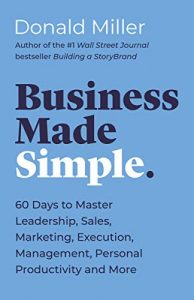Good communication skills. They’re not something we’re all born with.
But you can learn effective communication.
Everyone can become a great communicator – you just need some skills and rules to follow.
In his recent training video on creating effective presentations, Donald Miller presented his “7 Communication Skills No One Else Will Teach You”. You can apply these tips to any sort of communication, whether it’s an article, press release or a website.
Having loved his book “Building a Story Brand”, I was keen to learn more about his latest take on communication for business owners and marketers.
Miller is on a mission to create better communicators.
Sure, he’s selling his soon-to-be-released book and his Business Made Simple Course.
But his message is compelling.
Why is being a good communicator so important when you’re marketing your business?
Good communication gives you a competitive advantage.
From a personal point of view, good communication skills can increase your value as a leader or an employee.
As someone marketing a product or service, good communication makes you stand out.
Just look around. There’s a lot of ordinary business communication out there!
Here are Donald Miller’s 7 Communication Skills No One Else Will Teach You
1. Filter everything through a controlling idea
The controlling idea is the main point you want everybody to remember; the idea you’re trying to communicate.
- State your main idea first. Then repeat that idea in the middle and again at the end of the presentation.
- To hold onto your audience, you need to use your idea as a filter for all your other information. All communication should prove that this idea or theme is true.
- Give back-up details to support your controlling idea. And make the idea short, so people will remember it.
2. Repeat yourself over and over
You’re trying to get your audience to memorise your idea. That’s why you need to convey your main idea so it sticks.
- Use simple language. Repetition is not bad. After all, it’s how you build a brand. You’re making an impression so that the brand sticks. Short punchy words.
- Don’t try and sound smart.
3. Foreshadow a climactic scene in your speech
A climactic scene in a story is where all the conflict is resolved.
- You build-up the tension through your communication, hinting that there’s something people can look forward to. Something specific.
- Make it visual so they can remember it. Think of President Kennedy who summed up his space program by saying “We choose to go to the moon. Not because it’s easy. Because it’s hard.” His dream was clear.
4. Employ the right amount of drama
Don’t be afraid. People remember drama. Don’t be a dramatic person – make your content dramatic. Drama makes stories interesting.
- Throughout your communication, you’ll move from positive charge to negative charge. Think about your favourite movie. Something good happens to the hero, then the hero falls. Next scene he wins the day. It’s a flow.
- Without these highs and lows, your communication won’t be as compelling.
5. Define what’s at stake
What can be won or lost if you do or don’t buy this product or service (or agree with your controlling idea)?
If there’s nothing at stake, there’s no reason for people to change. They’ll stop paying attention. There’ll be no motivation to do something.
6. Open and Close your story loop
A story loop is at the big question at the heart of your narrative. Examples of a story loop from popular movies are: “Will Jason Bourne figure out who he really is?”, “Will Harry Potter survive and kill Voldemort?”.
- Open your story loop and ask questions.
- Keep the story loop going by presenting other challenges/questions – plots and sub-plots.
- The story close is the very end of your communication. That’s where everything is resolved. This is what keeps the audience’s attention. It motivates all human behaviour. All interest in your idea is motivated by story loops.
- A great story creates cliff-hangers that drive you into the next part of your story.
- Always resolve your story with a call to action. What’s the end result that your hero is seeking?
7. Create simple talking points
These talking points are repeated over and over again in your communication.
Invite your audience into narrative transportation. What’s that, you ask? A narrative transportation is a central truth that exists so that, when you hear an idea or paradigm as a narrative (story), you’ll have buy-in.
- If your audience buy-in is strong, they’ll reject all other facts that counter that narrative.
- Think about conspiracy theories. People hold onto totally implausible scenarios because they’ve bought into a story. Their brain has ‘locked onto’ a story, and they can’t let go.
- Donald Miller asks us to use this ‘for good, not evil’.
- Stay disciplined to your talking points so people remember your points.
- The point of communication isn’t to be impressive. It’s to be clear.
A lot to take in isn’t it?!
In summary, here’s Donald Miller’s Communication Made Simple Framework step-by-step:
- Define the controlling idea
- Posit the story question
- Agitate the problem
- Define the stakes
- Play the guide
- Provide a plan
- Offer a call to action
- Foreshadow the climactic scene
His new book Business Made Simple is out in January 2021. If it’s anything like his other books – Marketing Made Simple and Building A Story Brand – you’ll find it a handy reference and a worthwhile investment.




